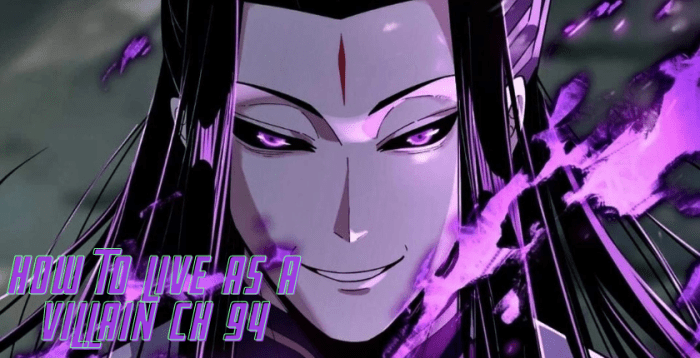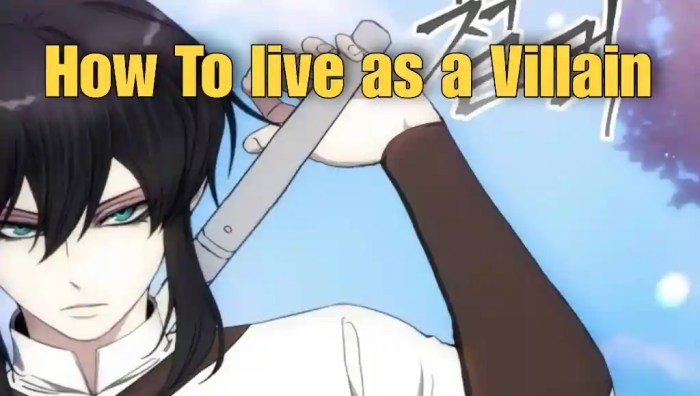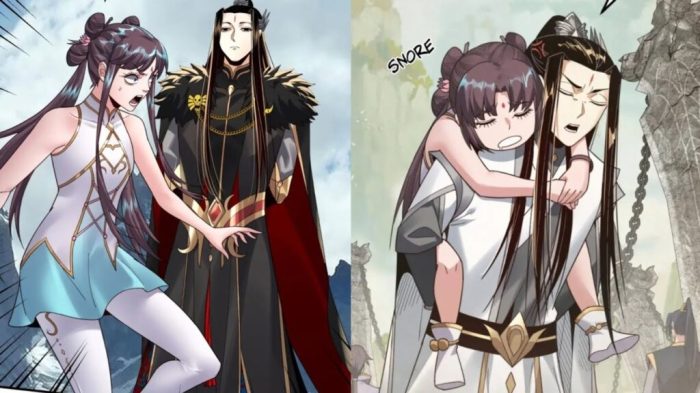
How to live as a villain ch 94 – In the captivating world of “How to Live as a Villain” Chapter 94, we embark on an extraordinary journey alongside a complex and enigmatic villain. As the narrative unfolds, we witness their rise to power, their cunning strategies, and the moral dilemmas that haunt their path.
Through a rich tapestry of character development, worldbuilding, and thematic exploration, this chapter delves into the psyche of a villain, revealing their motivations, fears, and the profound impact they have on the world around them.
Villainous Tactics and Strategies

To become a powerful and influential villain, one must employ cunning tactics and ruthless strategies. Throughout history, numerous villains have risen to prominence by exploiting the weaknesses of society and manipulating others to their advantage.
One effective tactic is to gain control over resources and assets. This can include acquiring wealth, technology, or access to information. By amassing power, villains can establish a stronghold and exert their influence over others.
How to live as a villain ch 94 is a fascinating topic that delves into the complexities of living as a villain. If you’re interested in exploring the motivations and strategies of villains, this chapter is a must-read. It offers a unique perspective on how villains operate and how they interact with the world around them.
Check out how to live as a villain ch 94 for more insights.
Divide and Conquer
Another strategy is to divide and conquer. By creating conflict and mistrust among different groups or individuals, villains can weaken their opposition and make it easier to control them. This tactic has been used successfully by villains such as the Roman emperor Nero and the Nazi leader Adolf Hitler.
However, it is important to note that the use of villainous methods raises significant ethical concerns. The pursuit of power and influence often comes at the expense of others, leading to suffering, injustice, and the erosion of moral values.
Character Development for Villains: How To Live As A Villain Ch 94

Creating a compelling villainous character requires careful consideration of their backstory, motivations, and personality traits. A well-developed villain should be relatable yet distinct, with a clear purpose and a sense of depth.
Backstory and Motivations
The villain’s backstory shapes their motivations and actions. Explore their past experiences, traumas, and events that led them down a path of villainy. Consider their relationships with family, friends, and society. Their motivations should be believable and relatable, even if they are ultimately evil.
Personality Traits
The villain’s personality traits define their behavior and interactions. Consider their intelligence, charisma, ruthlessness, and moral compass. They may possess a twisted sense of justice, a desire for power, or a deep-seated hatred that drives their actions.
Examples of Well-Developed Villains
Some examples of well-developed villains from literature, film, and other media include:
- Darth Vader (Star Wars): A tragic figure corrupted by power and driven by a desire for revenge.
- The Joker (Batman): A chaotic and unpredictable villain with a twisted sense of humor.
- Maleficent (Sleeping Beauty): A vengeful and powerful fairy who seeks revenge against those who wronged her.
Worldbuilding for Villainous Settings
Crafting a villainous setting demands careful consideration of its societal structure, political systems, and moral codes. A successful setting should align with the villain’s goals and motivations, fostering an environment where their actions make sense and their villainy can flourish.
If you’re looking for a new way to read how to live as a villain, check out how to live as a villain ch 94. This chapter takes the story in a whole new direction, and it’s sure to keep you on the edge of your seat.
You can find how to live as a villain ch 94 online at dakota.mecconline.org .
Social Structure
Villainous worlds often exhibit hierarchical social structures, with the villain occupying a position of power or influence. Their followers, henchmen, and minions form a loyal base, while the general populace may be oppressed or controlled through fear or manipulation.
Exploring the depths of the wicked, how to live as a villain ch 94 delves into the dark recesses of the human soul. This gripping chapter takes us on a treacherous journey, where morality is challenged and the boundaries of evil are tested.
From the cunning schemes of the malevolent to the righteous defiance of the innocent, this tale weaves a captivating tapestry of intrigue and conflict. Immerse yourself in the sinister world of how to live as a villain ch 94 and witness the unfolding drama of good versus evil.
Political Systems
Political systems in villainous settings can range from tyrannical dictatorships to corrupt democracies. The villain may seize power through force or cunning, establishing a reign of terror or exploiting existing institutions for their own gain. Opponents are silenced or eliminated, ensuring the villain’s dominance.
Moral Codes
Villainous settings challenge conventional morality, presenting a world where right and wrong are blurred. The villain may operate according to their own twisted code, disregarding societal norms and values. This moral ambiguity creates a sense of unease and tension, making the villain’s actions both horrifying and compelling.
Examples of Effective Villainous Settings
- Mordor (Lord of the Rings):A desolate wasteland ruled by Sauron, the Dark Lord, where darkness and evil permeate every aspect of society.
- Gotham City (Batman):A crime-ridden metropolis where the Joker and other villains terrorize the populace, challenging the city’s fragile sense of order.
- Hyrule (The Legend of Zelda):A once-peaceful kingdom corrupted by the evil Ganon, who transforms the land into a twisted realm of monsters and despair.
The Villain’s Journey
The villain’s journey is a tale of ambition, power, and ultimately, downfall. It is a story that has been told and retold for centuries, in every culture and every language. The villain is a complex and fascinating character, and their journey is one that is both tragic and inspiring.
The villain’s journey typically begins with a sense of injustice or loss. The villain may have been wronged by society, or they may have suffered a personal tragedy. This experience leads them to believe that the world is a cruel and unfair place, and that the only way to get ahead is to take what you want by force.
The Rise to Power, How to live as a villain ch 94
The villain’s rise to power is often a story of determination and cunning. The villain uses their intelligence and charisma to manipulate others and achieve their goals. They may form alliances with powerful people, or they may use their skills to blackmail or extort them.
The villain’s rise to power is often a gradual process, but it can also be sudden and dramatic.
The Downfall
The villain’s downfall is often as inevitable as their rise to power. The villain’s hubris and ambition often lead them to make mistakes. They may underestimate their enemies, or they may overreach themselves. The villain’s downfall is often a tragic event, but it can also be a moment of triumph for the hero.
The Role of the Hero
The hero is the villain’s opposite. The hero is a symbol of hope and justice. They are the ones who stand up to the villain and fight for what is right. The hero’s journey is often a story of courage and sacrifice.
The hero may have to overcome great obstacles, but they never give up. The hero’s victory over the villain is a victory for good over evil.
Themes and Symbolism in Villainous Narratives
Villainous narratives often delve into complex themes that resonate with audiences. These themes can range from the exploration of power and morality to the possibility of redemption. Symbolism plays a crucial role in enhancing the villain’s character and the story’s overall impact.
Power and Control
- Villains often seek power and control over others, driven by a desire for dominance or a sense of entitlement.
- The pursuit of power can corrupt and isolate the villain, leading to their downfall.
- Examples: Darth Vader’s transformation from a noble Jedi to a ruthless Sith Lord, driven by his desire for power.
Morality and Ethics
- Villains often challenge societal norms and question the boundaries of morality.
- Their actions may be driven by a twisted sense of justice or a belief that the ends justify the means.
- Examples: The Joker’s anarchic philosophy, which rejects societal rules and embraces chaos.
Redemption and Transformation
- Some villainous narratives explore the possibility of redemption for even the most heinous villains.
- Through character development and the exploration of their motivations, villains may find a path towards redemption.
- Examples: Zuko from Avatar: The Last Airbender, who initially serves as an antagonist but eventually redeems himself.
Symbolism
Symbolism can be a powerful tool in villainous narratives, enhancing the villain’s character and the story’s overall impact.
- Clothing and accessories: The villain’s costume or attire can symbolize their motivations or personality traits.
- Colors: Color symbolism can convey the villain’s emotions, intentions, or alignment.
- Objects and artifacts: Objects associated with the villain can hold symbolic significance, representing their power, goals, or flaws.
Final Review

As the chapter concludes, we are left pondering the complexities of morality, the nature of heroism, and the enduring legacy of villains in our stories and our lives. “How to Live as a Villain” Chapter 94 stands as a testament to the enduring fascination with the dark side, reminding us that even in the most sinister of characters, there may lie a glimmer of redemption.
Quick FAQs
What are the key strategies for villains to gain power and influence?
Villains employ a range of tactics, including deception, manipulation, intimidation, and alliances, to establish their power and influence.
How do you create a compelling villainous character?
Developing a villainous character involves exploring their motivations, backstories, and personality traits, ensuring they are relatable and evoke a range of emotions.
What are the characteristics of a villainous world?
Villainous worlds often feature oppressive social structures, corrupt political systems, and distorted moral codes that support the villain’s goals.





